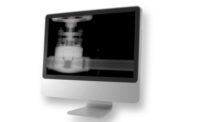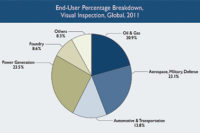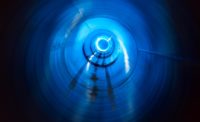Radiographic inspection is a critical practice across multiple industries, and the development of non-film radiography provides enormous, yet currently untapped, potential to share these images widely and maximize resources.
Radiography is an imaging technique using X-rays, gamma rays, or similar ionizing radiation and non-ionizing radiation to view the internal form of an object. In common terms, it is taking an X-ray of something. In applying radiography in an industrial application, it permits the interrogation of the internal nature of a component. It is often utilized to detect and evaluate shrinkage porosity, foreign material, and other internal flaws in metallic components.
Radiographic inspection of hardware is often required for components which are considered critical, such as aerospace engine components, medical implant devices, nuclear and traditional power generation components, etc. The process typically consists of a Level 1 technician (shooter) taking a series of radiographic exposures to be subsequently evaluated by a Level 2 technician (evaluator).
With the widespread acceptance and implementation of non-film radiography, either computed radiography (CR) or digital radiography (DDA), the Level 1 technician still needs to make the exposure(s) but instead of the end product being an analog radiograph, a photograph if you will, the product is now a digital image which is viewed on a high resolution monitor. As with any digital image, it can be transferred anywhere in the world, unlike a hard-copy radiograph. The current practice is to transfer the image to the other end of the building for viewing or perhaps to a storage device for transfer to the viewing building.
Need for Remote Radiography
Thinking outside the box, we are now in a world where there is a global economy and there are few barriers to doing business globally. The digital radiographic image can be transferred to a sister facility where there is surplus inspection capacity, limiting inspection costs incurred due to working overtime or worse yet, losing business as the customers’ schedule demands cannot be met. Throughput can be increased as a facility in a different time zone, perhaps even in a different hemisphere, can inspect the images during their normal working hours rather than leaving the image interpretation until the next day to be performed locally. Centrally located inspection hubs can be developed whereby images from satellite facilities transfer images for near real-time evaluation to take place. Markets with talented labor availability and lower labor costs can be utilized, all because of a mobile digital image.
Labor Efficiency with Remote Radiography
Having the right balance of available talented capacity to perform the evaluation can cause delays in the completion of the job or can cause excessive costs when the manager over staffs to ensure limited schedule delays or equipment down time. In either case, unnecessary costs can be the end result.
Down the road, what will happen when you are offered a large contract of work but the total labor demand far exceeds your current radiographic evaluator capacity? Are you going to simply hire more evaluators? A check on Indeed.com in mid-April 2020 shows a listing of 45 openings for industrial radiographic evaluators so competition for talent is fierce. Are you simply going to hire and train from the beginning? It typically takes a minimum of six months of supervised on-the-job experience to be eligible to test for certification, plus 80 hours of formal training, which is a considerable expense as well as a delay towards landing the contract. Having a larger pool of available talent can be the solution to your problem.
Implementation of Remote Radiographic Evaluation
The implementation of remote radiographic evaluation requires addressing certain key points but these are clearly surmountable:
- How will the images be transferred?
- How will image security be ensured?
- Who will be responsible for inspection accuracy?
- Who will be responsible for image archival?
- Who will perform the required inspector performance reviews?
- How will work be assigned to only those evaluators who hold the required certifications and have completed specific training on the particular product (alloy specific)?
Acceptance and Summary of Remote Radiography
Recognition of the need for remote radiographic evaluation has recently come from the National Aerospace and Defense Contractors Accreditation Program (Nadcap) with their approval and publication of the audit checklist AC7114/9, Audit Criteria for Non-Destructive Testing Remote Image and Film Viewing.
On a worldwide basis, the need to adopt the flexibility of remote radiographic image evaluation has been accepted and the process well defined. When thoughtfully implemented, it can improve a company’s competitive advantage without undue risk. NDT



